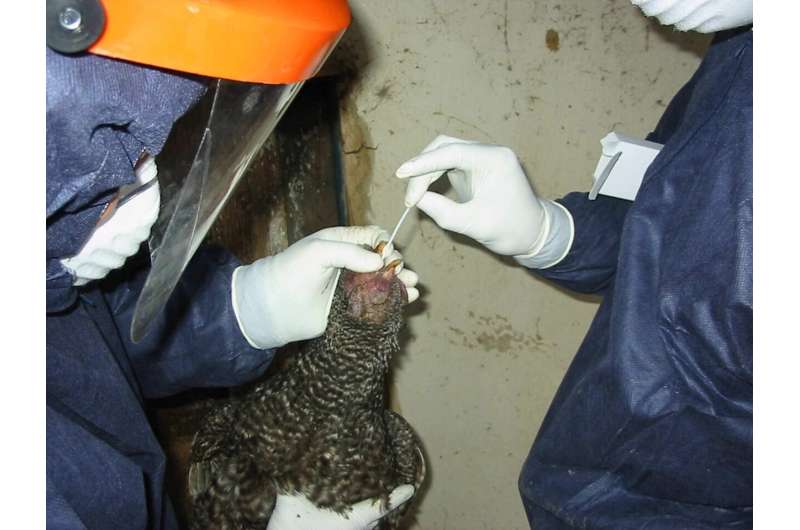This article has been reviewed according to Science X's editorial process and policies. Editors have highlighted the following attributes while ensuring the content's credibility:
fact-checked
trusted source
proofread
Scientists outline huge gaps in our surveillance of influenza viruses

The next pandemic that cascades through the human population could be caused by a new influenza virus strain concocted in animals, against which humans will have little to no immunity. That's the conclusion of Australian and Chinese scientists who analyzed close to five decades of animal influenza records.
Their study, published in One Health, is the result of a partnership project between Fudan University and the University of Sydney, led by Chinese researchers and co-authored by Professor Michael Ward from the Sydney School of Veterinary Science.
The team created a database of more than 70,000 records of animal influenza from 1970 to 2016, providing insights into the trends of these viruses over time and space. It gives public health authorities a framework to detect and track viral outbreaks in animals that threaten to emerge in human populations.
"This generates a solid foundation for understanding how, when and where animal influenza viruses could evolve into pandemic agents," Professor Ward said.
"We are recovering from the coronavirus pandemic now, but a flu virus that flares up and takes hold in humans has the potential to dwarf the impact from COVID-19 given the high mortality rates caused by some animal viruses."
The researchers concluded that bird flu might be the source of a new pandemic strain. Birds are natural hosts of a huge range of avian influenza subtypes. This, say the authors, increases the likelihood that bird flu could become zoonotic, that is, transfer from animal to human.
"The issue is whether a mutation within a subtype is going to be the one that suddenly gives a certain influenza virus the power to transmit person to person," Professor Ward said.
"The first barrier is getting into mammals. It's a big jump for a virus to go from birds into mammals, and then if it's transmitting quite well there's a greater chance it will jump into humans.
"It's just a numbers game. Viruses jumping species is not a rare event, so it's likely a virus will eventually make that final jump to humans."

Professor Ward said when two different influenza virus subtypes infect the same host cell, their genetic material can mix to create a new virus with the potential to trigger a pandemic. A bird virus that mutates in pigs before jumping to people, he continued, could create "a viral Armageddon and a confronting global health crisis."
An analysis of global events in the research found bird flu accounts for 79.6% of influenza in all animal hosts, followed by swine flu at 10.6%.
"H5N1 (avian influenza) is the big one at the moment. It's been big for the last two decades, and it seems to have got its mojo and be powering along quite well," Professor Ward said.
H5N1 has infected almost 900 people since 2003 with a death rate just shy of 52.5%, according to the World Health Organization. Since January 2022 in the United States, outbreaks of a branch of H5N1 known as 2.3.4.4b have affected more than 58 million fowl, resulting in the deaths or culling of most.
Professor Ward said Asia, North America and Europe have been the regions most likely to report new influenza subtypes. Sweden had the greatest diversity of subtypes, followed by the United States and China. The African continent, on the other hand, had no records in many countries, and data that exists showed a lower diversity of subtypes.
Professor Ward said globally imperfect animal influenza surveillance and data sharing means health authorities are unprepared to detect new strains of influenza or the next viral pandemic.
"One of the problems is implementing surveillance of animal viruses, it's always difficult to sample wild populations, particularly birds," Professor Ward said.
"The other side is domestic species, particularly poultry. If you report you've got viruses in your domestic poultry, there's trade impacts, there's potential human health blowback, so countries are reluctant to put all that information out in the public domain.
"There are big black holes in terms of influenza surveillance in places like South America and Africa. We just don't get many reports, so it's hard to know what's going on."
More information: Jiaqi Huang et al, Global epidemiology of animal influenza infections with explicit virus subtypes until 2016: A spatio-temporal descriptive analysis, One Health (2023). DOI: 10.1016/j.onehlt.2023.100514





















